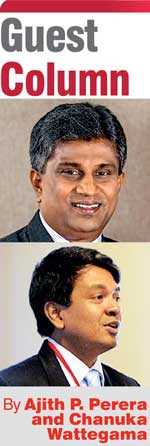Thursday Apr 10, 2025
Thursday Apr 10, 2025
Thursday, 20 June 2019 00:00 - - {{hitsCtrl.values.hits}}

Seya Sadewmi was a five-year-old girl who was abducted, raped and murdered. The body of this little girl, missing from her home for a little more than a day was found near a canal 200 m away. An autopsy revealed that Sadewmi had been sexually assaulted and was strangled to death. 
Initially, these were the only facts about the case. Kotadeniyawa police, under reasonable suspicions – according to them – arrested three individuals, including a 17-year-old student, one after another. Of course, Police should have been more careful. Still we all know not all suspects are guilty. Sadly in this case, a section of Sinhala print and electronic media irresponsibly made all three suspects, one by one, guilty on their own will. They generously offered stories on how she has been raped with vivid details. All outcome of sheer imagination. Later DNA tests revealed none of the suspects had anything to do with the incident. No media that have virtually made them ‘murderers’ ever bothered to admit the mistake, let alone apologise.
This incident was not seriously taken in a country with little respect for media ethics. After all, we live in a country with reporters discovering brick structures in Mars and airplanes are brought down by birds hitting ‘software’ of equipment!
Students of journalism perhaps learn the history of disinformation generation, which of course is as old as the industry itself. Through centuries printers have found publishing sensational disinformation can bring a boom – though temporary.
Invention of printing press was not automatically followed by media ethics or fair practices. Neither were any state regulation or guidelines present on earlier days. Printers printed what they thought would sell most. Dispersal of disinformation was common. Fake news-sheets called ‘canards’ were sold in Paris on the street for two centuries, starting in the 17th century.
They were largely the reason for the unpopularity of ‘foreign queen’ Marie Antoinette. Contrary to the popular belief she was a decent kind and civilised human being, not a snob. The words “Let them eat cake” was not her own. The saying appears in the autobiography of the French writer Jean-Jacques Rousseau, written in 1765, when Marie Antoinette was nine years of age. Still she had to die in 1793, guillotined in part because of popular hatred engendered by a canard which printed her face distorted.
19th century saw a boom in disinformation with the proliferation of print media in North America and Europe. The most famous example was the Great Moon Hoax of 1835. The New York Sun carried a series of news stories about an astronomer who observed bizarre creatures on the moon. These fictionalised content successfully attracted new subscribers. Sales increased. The newspaper received little rebound after acknowledging the series as fraud next month. In terms of business, it has been a success.
20th century, with two world wars, offered even a better ground for disinformation creators. Some famous examples include the works of Joseph Goebbels, Hitler’s Reichsminister of Public Enlightenment and Propaganda for 12 years. Particular interest of Goebbels was on radio, a new media channel that was getting increasingly popular at that time. In the WW II, following the surrender of any country, Goebbels’ Propaganda Ministry took over all the radio channels and started their own propaganda gaining the trust of the citizens.
As almost all German and conquered countries’ media were controlled by Goebbels and his department masses hardly had access to any other versions. The German Home Service, the Armed Forces Program, and the German European Service were all rigorously controlled in information they were permitted to disseminate and even the music they were allowed to play. Coverage of party rallies, speeches and demonstrations were the focus of news. Short promotional films were shown using 1,500 mobile film vans.
As the war progressed, Hitler made the public appearances and broadcasts less. Thus Goebbels became increasingly the voice of the Nazi regime. A stern believer of the idea a lie uttered hundred times transforming to truth, Goebbels vehemently denied the existence of Nazi concentration camps till they were discovered only after the war end.
In an ideal world, advent of Internet and Web 2.0 should have curtailed the disinformation. They provide adequate opportunities for somebody to recheck a story. Unfortunately, what happened was the opposite. The spread has augmented. Consequently the influence of disinformation is today more significant thanks to their virality and the way in which some of the social media platforms operate.
While social networks were not initially designed to be a news media, they have evolved to be with the ease of sharing information. Social networks are known for their speed of circulation of content as well as the non-verification of information. These specificities make social networks a medium relatively simple to manipulate by disinformation generators.
Current American President’s name is often heard in line with disinformation stories. Donald Trump is a heavy user of Twitter, which he depends on to disseminate his views. Some of his posts have been controversial. Trump has previously tweeted about vaccines, which – according to him – are the cause of the dramatic increase in the number of cases of autism, and on global warming, which – according to him – would be “an invention of the Chinese”. Riding on the same wave disinformation creators have targeted Trump for their stories. The Washington Post estimated in August 2018, Trump-related content averages 7.5 fake news stories per day, or more than 4,000 since the beginning of his term.
Disinformation is vicious and harmful
Anyway, there is no argument that disinformation should be controlled for the benefit of the society at large. They are just not fake. Most of the times, they are vicious and harmful.
Some countries like Singapore criminalise the propagation of disinformation. Under existing Singaporean law, “Any person who transmits or causes to be transmitted a message which he knows to be false or fabricated shall be guilty of an offense”.
Following several dubious incidents, K. Shanmugam, Singapore’s Minister of Law has initiated specific legislation to combat disinformation in 2018. This is in addition to Ministry of Communications and Information’s attempts to set up a dedicated website to debunk false rumours regarding issues of public interest such as the environment, housing and transport. In 2018, the Parliament of Singapore also formed a Select Committee to consider new legislation to confront disinformation. Singapore government recently passed legislation, called the Protection from Online Falsehoods and Manipulation Act (POFMA).
POFMA gives Singaporean government extensive powers to issue a variety of orders to break the virality of online falsehoods, blacklist websites which repeatedly publish disinformation, and introduce codes of ethics to require technology companies to put in place measures to fight the scourge. Particularly, falsehoods that are shared on closed platforms like chat groups and social media groups are also covered, no matter if they may be private, as these are seen as ideal platforms for spreading falsehoods.
Malaysia enacted an Anti-Fake News Bill in April 2018, in fact being the first country in South East Asia to do so – even before Singapore. This is a controversial law that deemed publishing and circulating misleading information as a crime punishable by up to six years in prison and/or fines of up to MYR 500,000 (over Rs. 20 million).
Before Malaysian parliamentary elections Mahathir Mohammad has vowed to abolish the disinformation law in his campaign, as the law was targeted at him by previous government. However, after the election, the newly elected Prime Minister has stated “Even though we support freedom of press and freedom of speech, there are limits.” As of May 2018, Mohammad has supported amending the law, rather than a full abolition.
Malaysian law is strong on definitions. ‘Fake news’ includes any news, information, data and reports which is or are wholly or partly false, whether in the form of features, visuals, or audio recordings or any other form capable of suggesting words or ideas. ‘Publication’ includes (a) any written publication or publication of a nature similar to a written publication and every copy or reproduction, be it digitally, electronically, magnetically or mechanically produced.
Sri Lanka following 4/21 attacks now has more reasons than before to control disinformation. Whether we like it or not, we are now in war with global terrorist forces. This is no joke. The current battle is far more difficult and complex than what was against LTTE, a local guerrilla terrorist group with hardly any international links. We have seen how disinformation has initiated communal hatred. Sometimes they have resulted in physical damages.
It is essential that the state has control over what is presented to public at critical situations, but news channels are not organised that way. We cannot let the masses go astray over disinformation items. It is not a question of ‘correcting’ them. That is not the issue. Fake news stories have the debauched ability to make masses depressed. This can make them behave in an undesired manner, which even they may not try under normal circumstances. That is what requires to be ceased.
Finally, we also hope the ‘media activists’ and ‘social media activists’ are mature enough to understand the difference between what we call the ‘media freedom’ and the unregulated liberty to spread falsehoods. One may have a right to know the truth. No arguments on that. Still does one also have the right to know lies; particularly if such lies lead to serious repercussions on the society at large? We doubt.
(Ajith P. Perera is the Minister of Digital Infrastructure and Information Technology and Chanuka Wattegama is a business writer.)
Discover Kapruka, the leading online shopping platform in Sri Lanka, where you can conveniently send Gifts and Flowers to your loved ones for any event including Valentine ’s Day. Explore a wide range of popular Shopping Categories on Kapruka, including Toys, Groceries, Electronics, Birthday Cakes, Fruits, Chocolates, Flower Bouquets, Clothing, Watches, Lingerie, Gift Sets and Jewellery. Also if you’re interested in selling with Kapruka, Partner Central by Kapruka is the best solution to start with. Moreover, through Kapruka Global Shop, you can also enjoy the convenience of purchasing products from renowned platforms like Amazon and eBay and have them delivered to Sri Lanka.
Discover Kapruka, the leading online shopping platform in Sri Lanka, where you can conveniently send Gifts and Flowers to your loved ones for any event including Valentine ’s Day. Explore a wide range of popular Shopping Categories on Kapruka, including Toys, Groceries, Electronics, Birthday Cakes, Fruits, Chocolates, Flower Bouquets, Clothing, Watches, Lingerie, Gift Sets and Jewellery. Also if you’re interested in selling with Kapruka, Partner Central by Kapruka is the best solution to start with. Moreover, through Kapruka Global Shop, you can also enjoy the convenience of purchasing products from renowned platforms like Amazon and eBay and have them delivered to Sri Lanka.